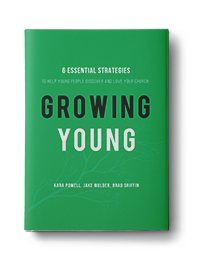Meet the churches young people are loving (and not leaving)
 Jake Mulder | Jun 13, 2016
Jake Mulder | Jun 13, 2016
Growing Young began with some ambitious questions.
What can churches do to become more effective with young people? Who and where are the most innovative congregations in the country when it comes to engaging young people well? How might we learn more about them?
When our team set out to answer these questions, we knew we had a long road ahead of us. As Brad shared recently, the aging and shrinking of the American church is a far-reaching dilemma. To discover hopeful and meaningful answers, we knew we’d need a comprehensive research project.
As we began to strategize, we realized that this study would involve more than just one seminary, one denomination, or one region of the country. In fact, our questions led us on an 80,000-mile journey around the US to discover churches that young people find irresistible.
Meet the churches young people love
Throughout our research, we encountered hundreds of remarkable and diverse congregations who represent tens of thousands of young people. These teenagers and young adults consistently said they felt “known” at their church. They knew that no matter what happened, their church would feel like “home.”
There was the East Coast 1000-member Presbyterian church that developed a long-term high school ministry team that pours into volunteer adult leaders, who in turn build a web of support around students.
And the 100-member midwestern rural Reformed church that has become so hospitable to teenagers and young adults that being at church is now the highlight of their week.
And the 1500-member urban multiethnic congregation in the South that launched two leadership training programs for young adults in their city.
And the 5000-member nondenominational church that responds to young people’s core questions and struggles with an authentic exploration of the gospel rather than trite answers.
And the 200-person urban Baptist Latino congregation that integrated English into its worship services to better engage young people. This church is literally learning a new language in order to grow young.
Defining an effective church
Identifying outstanding churches like these began with a simple definition. In conversation with a team of nearly 30 scholars, pastors, and thought leaders, we nailed down the following description:
A church that is effective with young people is one that is involving and retaining young people in the congregational community, as well as helping them develop a vibrant faith in Jesus Christ.
Simply put, we now describe these as churches growing young because:
- They are engaging young people ages 15-29, and
- They are growing—spiritually, emotionally, missionally, and sometimes also numerically.
How we identified churches for our study
Working largely through Fuller Seminary’s vast network, we solicited names of vibrant congregations from over 35 nominators who fell into three categories:
National denominational leaders from 13 Protestant denominations as well as the Roman Catholic Church and Greek Orthodox Church.
Respected scholars from seven educational institutions: Fuller Theological Seminary, Princeton Theological Seminary, Wheaton College, North Park University, Gordon College, Trinity Evangelical Deerfield School, and Luther Seminary.
Other experts in ministry to young people outside of specific denominational channels including the Willow Creek Association, Orange, the Youth Cartel, Catalyst, and our own Fuller Youth Institute team.
We asked these nominators to identify congregations that have ministries with young people that are numerically growing, are engaging a large number of young people relative to the size of their congregation, or have something “exciting or missional” going on with young people.
The diversity of churches growing young
Wondering whether any of these churches are similar to yours?
Almost certainly.
Since the launch of the project, we have been pleased by the rich diversity of churches who graciously accepted our invitation, responded to online surveys, answered questions by phone, and opened their doors (literally!) to us. Here’s a snapshot of how the 259 churches that chose to participate in the research describe themselves.
Denominational affiliation. 21 major church traditions were represented, including: Anglican, Assemblies of God or Pentecostal, Baptist, Christian & Missionary Alliance, Church of Christ, Church of God in Christ, Disciples of Christ, Episcopal, Evangelical Covenant, Evangelical Lutheran, Greek Orthodox, Lutheran Church-Missouri Synod, Nazarene, Presbyterian, Reformed or Christian Reformed, Roman Catholic, United Methodist, and those claiming no denominational affiliation.
Congregation size. Churches ranged in size from under 100 participants to over 10,000 participants. The largest three categories were 1,001-3,000 (28 percent), 501-1,000 (24 percent), and 251-500 (15 percent).
Racial diversity. Just over half of the congregations were predominantly white, one-third were multiracial, and the others were predominantly African American, Hispanic/Latino, or Asian.
Region of the US. Geographic location included all census regions of the country, with representations from the Midwest (33 percent), West (31 percent), South (25 percent), and Northeast (11 percent).
Age of church: The study included newer church plants that were less than five years old as well as historic congregations with over 140 years of history.
Type of community: In terms of where the congregation was located, 56 percent reported being suburban, 33 percent urban, 3 percent rural, and 8 percent a mix of urban, suburban, and rural that was difficult to distinguish.
More stories of hope are on the way
We’ve done the hard work of finding and visiting these churches because we want to move beyond the bad news about young people leaving the church, and give you access to what’s actually working. There are so many more churches from the project for you to meet!
God is doing amazing things in different types of churches around the country – we’re thrilled to share more of their stories in the coming months.

All churches grow old. Strategic churches are growing young.
More From Us



Sign up for our email today and choose from one of our popular free downloads sent straight to your inbox. Plus, you’ll be the first to know about our sales, offers, and new releases.



